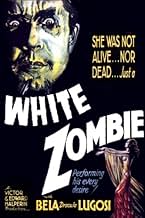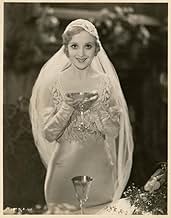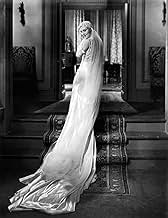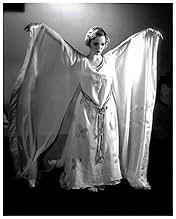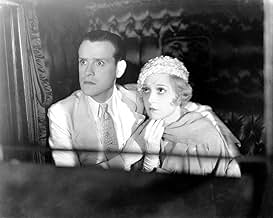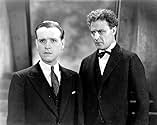NOTE IMDb
6,2/10
12 k
MA NOTE
Un jeune homme se tourne vers un sorcier pour attirer la femme qu'il aime loin de son fiancé, mais la transforme en esclave zombie.Un jeune homme se tourne vers un sorcier pour attirer la femme qu'il aime loin de son fiancé, mais la transforme en esclave zombie.Un jeune homme se tourne vers un sorcier pour attirer la femme qu'il aime loin de son fiancé, mais la transforme en esclave zombie.
- Réalisation
- Scénario
- Casting principal
John T. Prince
- Ledot - Zombie
- (as John Printz)
Clarence Muse
- Coach Driver
- (non crédité)
Avis à la une
You have to change your way of looking at movies to really enjoy old horror movies like this one. Don't be in a rush to see action, violence and don't expect to see any bloodshed at all. Most of the grisly part is implied and you have to fill in the details. Instead, watch it for the scenery, the acting and the plot.
I prefer the older horror films to the newer, slash-fest movies because they allow me to think and they generally have a good, moral theme. You never have a good guy as a demon or a fiend, for instance.
White Zombie has the older, traditional zombie characters that are not evil in themselves. Instead, they are mindless and controlled by a shaman, who is generally evil and must be destroyed to set the zombies, who are victims, free. In the newer Zombie movies like Night of the Living Dead, the Zombies are either not controlled or are evil themselves and must be destroyed.
I think the acting by the zombies is very good and so is their make-up (i.e. they have very frightening faces.) Their master, played by Bela Lugosi, is also played masterfully. The missionary is also good, but most of the rest of the cast is only average.
It's a fun movie to watch and I gave it a score of 7 out of 10. If you love early horror movies, buy it. Don't pay more than $10 unless it's packaged with other movies because the picture and the sound quality are weak. If not, you might catch it on a Friday night horror fest on TV. It's worth the time watching it if for Bela Lugosi alone.
I prefer the older horror films to the newer, slash-fest movies because they allow me to think and they generally have a good, moral theme. You never have a good guy as a demon or a fiend, for instance.
White Zombie has the older, traditional zombie characters that are not evil in themselves. Instead, they are mindless and controlled by a shaman, who is generally evil and must be destroyed to set the zombies, who are victims, free. In the newer Zombie movies like Night of the Living Dead, the Zombies are either not controlled or are evil themselves and must be destroyed.
I think the acting by the zombies is very good and so is their make-up (i.e. they have very frightening faces.) Their master, played by Bela Lugosi, is also played masterfully. The missionary is also good, but most of the rest of the cast is only average.
It's a fun movie to watch and I gave it a score of 7 out of 10. If you love early horror movies, buy it. Don't pay more than $10 unless it's packaged with other movies because the picture and the sound quality are weak. If not, you might catch it on a Friday night horror fest on TV. It's worth the time watching it if for Bela Lugosi alone.
Zombie movies from the '30's and '40's are quite different from the zombie movies most people know from the '70's till present time. In the '30's and '40's, zombies and voodoo kind of rituals always walked hand in hand. As a result of this zombie movies from the '30's and '40's have a certain creepy atmosphere and scary voodoo sound effects.
"White Zombie" is the very first (still excising) zombie movie ever made. The zombies look extremely good and creepy thanks to the charismatic actors that perform them. Don't underestimate this people, acting with just your body and mostly face is also a form of tough acting. I think that it is thanks to the fine casting of the zombies that most of the scene's with them in it, work really well.
Bela Lugosi is totally fantastic as sort of witch doctor and 'king of the zombies'. He plays one scary monsieur. I even tend to say that this is his best villain role he has ever portrayed, yes even better as Count Dracula. Lugosi was always at his best in roles like these and just like in "Dracula" he is once more acting very well with also both his hands and face, especially his typical horror-like-eyes make him one legendary villain. For the Lugosi fans this is an absolute must see!
The story is very intriguing and sad and its told in a beautiful way. Especially the ending was fantastic and actually also quite tense.
Unfortunately time has not been kind on this movie. The movie had been lost for many years until the '60's after acquiring the rights to distribute the movie, the quality was already beyond restoration, so now days we can never watch this movie in its full glory. The movie has the grainy and visual look of movies from the 1920's and at times small chunks of sound and music are missing.
The cinematography is absolutely fantastic and the experimental editing provides some unique and extremely well looking sequences. It reminded me of some of Brian De Palma's early work. There is one unique and brilliant scene that I can't even describe. It features a split screen but the scene is constructed more complex than I make it sound. Really something you have to see for yourself.
OK maybe the beginning of the movie isn't that good and memorable and quite standard and typical for the horror genre in the '30's but the last half hour or so is really unique, excellent, tense and just a shear delight to watch, mainly thanks to Bela Lugosi's his character 'Murder' Legendre (what a brilliant name by the way) and the story in which once more love conquers all.
By the way this is the movie Ed Wood and Bela Lugosi were watching together in the movie "Ed Wood". Most people think that it was a Dracula movie with Lugosi but it in fact is this movie they're watching.
A really unique little forgotten horror masterpiece, that's worth seeing already alone for its movie historical value and Lugosi's fantastic, passioned villain role.
8/10
http://bobafett1138.blogspot.com/
"White Zombie" is the very first (still excising) zombie movie ever made. The zombies look extremely good and creepy thanks to the charismatic actors that perform them. Don't underestimate this people, acting with just your body and mostly face is also a form of tough acting. I think that it is thanks to the fine casting of the zombies that most of the scene's with them in it, work really well.
Bela Lugosi is totally fantastic as sort of witch doctor and 'king of the zombies'. He plays one scary monsieur. I even tend to say that this is his best villain role he has ever portrayed, yes even better as Count Dracula. Lugosi was always at his best in roles like these and just like in "Dracula" he is once more acting very well with also both his hands and face, especially his typical horror-like-eyes make him one legendary villain. For the Lugosi fans this is an absolute must see!
The story is very intriguing and sad and its told in a beautiful way. Especially the ending was fantastic and actually also quite tense.
Unfortunately time has not been kind on this movie. The movie had been lost for many years until the '60's after acquiring the rights to distribute the movie, the quality was already beyond restoration, so now days we can never watch this movie in its full glory. The movie has the grainy and visual look of movies from the 1920's and at times small chunks of sound and music are missing.
The cinematography is absolutely fantastic and the experimental editing provides some unique and extremely well looking sequences. It reminded me of some of Brian De Palma's early work. There is one unique and brilliant scene that I can't even describe. It features a split screen but the scene is constructed more complex than I make it sound. Really something you have to see for yourself.
OK maybe the beginning of the movie isn't that good and memorable and quite standard and typical for the horror genre in the '30's but the last half hour or so is really unique, excellent, tense and just a shear delight to watch, mainly thanks to Bela Lugosi's his character 'Murder' Legendre (what a brilliant name by the way) and the story in which once more love conquers all.
By the way this is the movie Ed Wood and Bela Lugosi were watching together in the movie "Ed Wood". Most people think that it was a Dracula movie with Lugosi but it in fact is this movie they're watching.
A really unique little forgotten horror masterpiece, that's worth seeing already alone for its movie historical value and Lugosi's fantastic, passioned villain role.
8/10
http://bobafett1138.blogspot.com/
There's something about 1930s horror movies that makes them really special and haunting. It's probably got a lot to do with the talkies being new and directors being free to experiment with tricks learned from German expressionism. Whatever the explanation the best movies from the early 30s (James Whale's 'Frankenstein', 'Bride Of Frankenstein' and 'The Invisible Man', Todd Browning's 'Dracula' and 'Freaks') have a dreamlike quality that sticks in your brain and just won't leave. Bela Lugosi is one of the icons of horror movies. He made 'White Zombie' not long after 'Dracula', his definitive role, and gives another great performance. 'Island Of Lost Souls' is a better movie than 'White Zombie' but Lugosi on has a small role in that so I'd say this is his best movie after 'Dracula'. It's easy to forget just how quickly his career died. His two mid-30s teamings with Boris Karloff ('The Black Cat' and 'The Raven') were basically the beginning of the end for him as a major star, and by the time he played Ygor in the underrated 'Son Of Frankenstein' at the end of the decade he was almost a has been. Oh well Lugosi is just terrific in this movie as the sinister 'Murder' Legrende, Haitian mill owner and zombie master. Robert Fraser plays Charles Beaumont, a local plantation owner who becomes obsessed with a young woman (Madge Bellamy) about to be married. He invites her and her fiance (John Harron) to his estate to have their wedding all the while planning some way to win her. An hour before the wedding he becomes desperate and reluctantly approaches his sinister neighbour Legrende. Legrende's solution has dire consequences for all involved. The movie was obviously made a shoe string budget but there are plenty of striking visual images, especially those involving Bellamy after Lugosi gets to her. The zombies are very creepy and are the precursors to zombie classics later made by Tourneur, Romero, Fulci and Raimi. For this and for Lugosi 'White Zombie' is a must see for any horror buff!
White zombie is recorded as being the first Zombie movie ever mad. They Zombie actors did an amazing job of it, especially when considering they had no bases to work from. It was all about portraying creepy and terrifying through a stiff body poster and facial features. And they pooled it off. It was the "eyes" of Lugosi, the king of Zombies who put the fear in me. Amazing skills as an actor to convey so much with just the eyes. The movie is at one scary, mysterious, weird, and funny. The key feature of White zombie is that it was made to scar the people of its time, not ours. And this is probably why most people won't give it the time of day. It is an old movie with old style acting and scare tactics. The viewer has to know that be for watching it.
WHITE ZOMBIE is one of those rare early talkies where everything fits just right. Rumours have circulated for years that Bela Lugosi himself actually directed part, if not all, of the movie. Having seen all of the movies made by the Halperin Brothers in the 30's this is deffinitely the best, but DID Bela direct it? There is a quality in this film lacking from all other Halperin films. In many scenes the technique seems to have been borrowed from German silent films and Bela did work with Edgar Ulmer in Germany early in his career. Also notice that WHITE ZOMBIE is essentially a silent film with key scenes performed with a minimum of dialogue . . .or none at all; a standout moment is when Legendre (Bela Lugosi) traps the soul of Madeline (Madge Bellamy) by carving, and then melting, a wax image in her likeness. All without a single word being said. Another key sequence is a montage of scenes set against the haunting spiritual "Listen To The Lambs" performed by an offscreen chorus. Notice also the scene where Neil (John Harron, brother of former silent film star Robert Harron) and Dr. Bruner (Joseph Cawthorn) are talking. The camera starts out behind Harron's back and moves out. It moves in a circle around the room while the men talk and finally goes back behind Harron to end the scene; deffinitely an Expressionist Germanic touch! Granted the film has its flaws, Joseph Cawthorn's character is supposed to be to be a Christian missionary but he has a noticably Yiddish accent. Also for a film that is set in Haiti there is an uncomfortable lack of black characters. Clarence Muse as the coach driver is the only one in the movie! Two other alleged native Haitians are white actors in blackface! Madge Bellamy's bee-stung lips and eye makeup also belong back in a silent film. Weighed against the film as a whole however, these inadequacies are slight. The cast is quite good. Robert Fraser met up with Lionel Atwill in THE VAMPIRE BAT (1934). Clarence Muse met up with Bela again in THE INVISIBLE GHOST (1944). One of the zombies is played by George Burr McAnnan who had played the puritannical leader of the farm community that ostracises unwed mother Lillian Gish in WAY DOWN EAST (1920). Also look for Brandon Hurst as a creepy looking butler. He had played the evil Jehan Frollo opposite Lon Chaney's Quasimodo in THE HUNCHBACK OF NOTRE DAME (1923). By all means see this movie! It is well worth your time. So did Bela direct it? Alas we may never know. Then again, in an interview given in the early 1970's Clarence Muse said he clearly recalled Bela directing a few scenes. So maybe . . .
Le saviez-vous
- AnecdotesWas a personal favorite of Bela Lugosi, according to his son, Bela Lugosi Jr..
- Gaffes(at around 46 mins) The vulture manages to scream, loudly and repeatedly, with its beak shut.
- Citations
Madeline: Driver, who were those men we saw?
Coach Driver: They are not men, madame. They are dead bodies!
- Crédits fous"White Zombie starring Bela (Dracula) Lugosi."
- Versions alternativesThe scene is which the zombie is crushed by the grinder, after falling into the chute in the factory, is missing from most available prints.
- ConnexionsEdited into Revolt of the Zombies (1936)
- Bandes originalesBridal Chorus (Here Comes the Bride)
(uncredited)
from "Lohengrin"
Music by Richard Wagner (1850)
Played on an organ for the wedding
Meilleurs choix
Connectez-vous pour évaluer et suivre la liste de favoris afin de recevoir des recommandations personnalisées
- How long is White Zombie?Alimenté par Alexa
Détails
- Date de sortie
- Pays d’origine
- Langue
- Aussi connu sous le nom de
- White Zombie
- Lieux de tournage
- Société de production
- Voir plus de crédits d'entreprise sur IMDbPro
Box-office
- Budget
- 50 000 $US (estimé)
- Durée1 heure 9 minutes
- Couleur
- Rapport de forme
- 1.37 : 1
Contribuer à cette page
Suggérer une modification ou ajouter du contenu manquant

Lacune principale
By what name was Les Morts-vivants (1932) officially released in India in English?
Répondre


